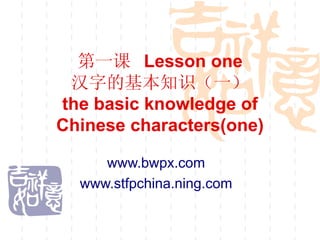
I _Chinese Characters Lecture_Lesson1
- 1. Lesson one the basic knowledge of Chinese characters(one) www.bwpx.com www.stfpchina.ning.com
- 2. Where do Chinese characters come from? 3000 Chinese characters have had a history of more than 3,000 years. Ancient Chinese characters were pictographic, outlining the rough shape of things with simple lines. For instance, ancient people used to symbolize “ and used to symbolize “
- 3. We divide Chinese characters into two categories according to its structure: Independent characters and combined characters. We divide Chinese characters into four categories according to its creation methods: pictographic characters; indicative characters; associative characters; picto-phonetic characters.
- 4. What is independent characters? It is composed of strokes, it cann’t be divided, it contains pictographic characters and indicative characters.
- 5. 1 5% pictographic characters to show the characters’ meaning according to outline the rough shape of things with simple lines, only 5% of all Chinese characters belong to the pictographic kind. For instance:
- 7. 2 indicative characters to show the characters’ meaning according to abstract symbols. For instance: Add a short line on a long line , it is “ , Add a short line under a long line , it is “ , Add a short horizontal under the tree , it is “ , Add a dot on the knife , it is “ .
- 8. What is combined characters? It is composed of two or a few parts, it contains associative characters and picto-phonetic characters. 1 associative characters it is composed of two or a few independent characters, to show a new meaning. For instance: + = + = + = + =
- 9. 2 pictophonetic characters It is composed of two parts, one part shows the character’s meaning, the other part shows the character’s pronunciation. We call the meaning part as meaning radical, we call the pronunciation part as phonetic radical. For instance: + = + = + = + =
- 10. 8 kinds basic strokes of Chinese characters’ : 20 8 8 Chinese character is composed of strokes, there are more than 20 kinds strokes, there are 8 kinds basic strokes among them.
- 11. héng ---- horizontal It has two forms, long horizontal and short horizontal. When we write it, pay attention to the way of writing, it is from left to right, and it must be written levelly. For instance:
- 12. shù---- vertical It has two forms, long vertical and short vertical. When we write it, pay attention to the way of writing, it is from top to bottom, and it must be written straightly. For instance:
- 13. piě---- left-falling It has two forms, level left-falling and vertical left-falling. the way of writing is from top to lower left, it is softly. They are different between “ and “ . For instance:
- 14. nà---- right-falling It has two forms, level right-falling and vertical right-falling. the way of writing is from top to lower right, it is softly. For instance:
- 15. zhé----turning héng zhé and shù zhé It has two forms, horizontal-turning and vertical-turning, When we write it, pay attention to it is one stroke. For instance:
- 16. shù gōu---- vertical hook It likes a fish hook, When we write it, pay attention to the hook is sharp and short. For instance:
- 17. diǎn---- dot It has two forms, left-dot and right-dot, When we write it, pay attention to dot to lower right and pause or dot to lower left and pause. For instance:
- 18. tí---- rising It is dot from bottom-left to top-right. For instance: 8 The character includes 8 kinds basic strokes, it is “
- 19. the rules of the strokes order: Every character has its rules of the strokes order, following the correct stroke order one can raise the speed of writing and ensure correctness.
- 20. 1 Ten 2 Person 3 Small 4 Three 5 Eight 6 Moon 7 Four
- 21. The rules of the Example Meaning The strokes order strokes order 1 Horizontal before Ten vertical 2 Left-falling before Person right-falling 3 Middle before two Small sides 4 Form top to bottom Three 5 Form left to right Eight 6 Form outside to inside Moon 7 First come in, close Four the door at the last
- 22. the basic structure of Chinese characters There are two main structures in Chinese characters, one is independent characters, it is complete, independent because it is composed of the strokes; the other is combined characters. The combined characters include three kinds of structures. 1 left-right structure 2 top-bottom structure 3 inside-outside structure
- 23. All of the following characters are pictographic characters, can you guess their meaning? 1 7 2 8 3 9 4 10 5 11 6 12
- 24. give the name of the following characters:
- 25. Count the strokes of the following characters 1 2 3 4 5 6 7 8
- 26. give the structure of the following characters : : :
- 27. find the same part of the following characters 1. 2 3 4 5 6 7 8
